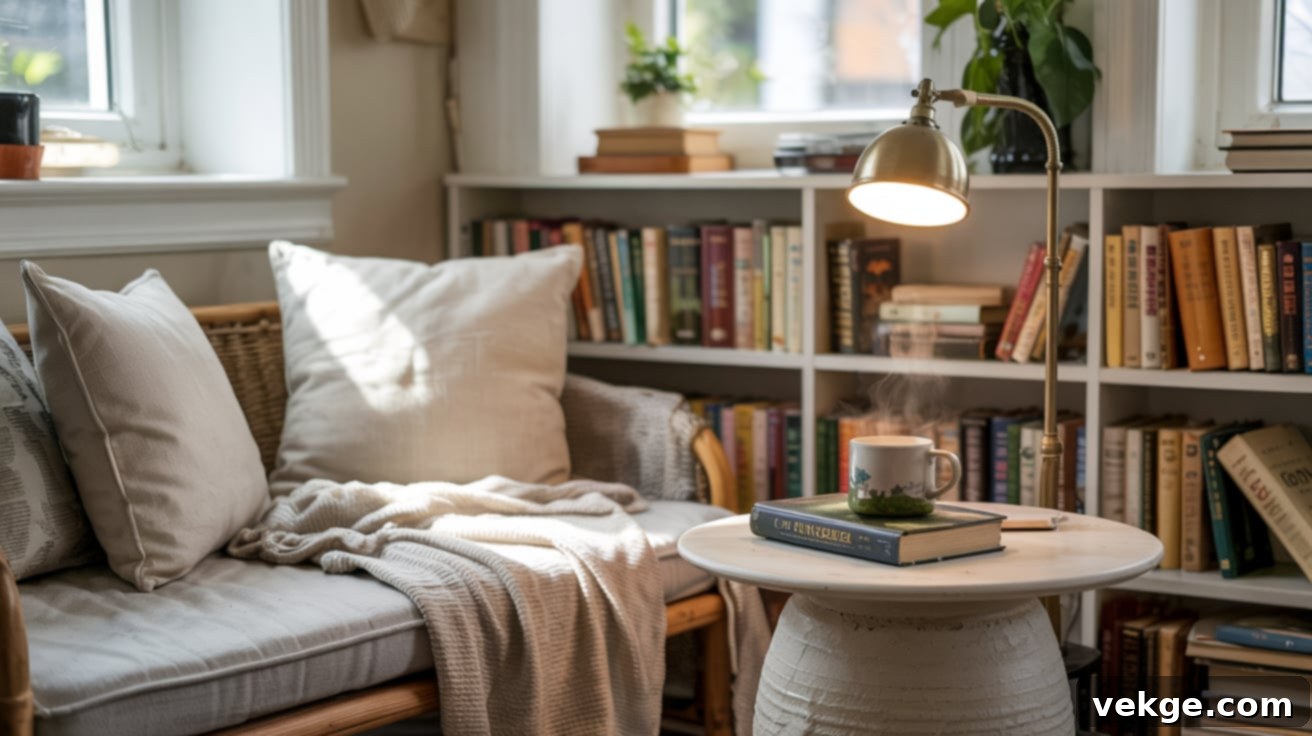Transform Any Corner: Your Ultimate Guide to Building a DIY Reading Nook
Have you ever dreamed of a small, tranquil space just for yourself, or perhaps for your children, a dedicated spot where you can comfortably sit, read, and simply relax? The good news is, this personal sanctuary isn’t out of reach. You don’t need an expansive room or an unlimited budget to make it happen. With a bit of creativity and some simple pieces, you can set up your very own DIY reading nook with ease.
In this comprehensive guide, we’ll walk you through every step of the process: from careful planning and identifying the perfect location in your home, to selecting the right furniture and adding those essential comfort elements. Whether you reside in a spacious house, a cozy apartment, or are navigating the unique challenges of a small living space, you’ll discover practical ideas and actionable tips that fit your specific needs. Ready to transform that unused corner into your favorite, most cherished spot? Let’s dive in and create your ultimate reading haven.
Understanding the Purpose and Benefits of a DIY Reading Nook
A DIY reading nook is far more than just a designated chair; it’s a thoughtfully designed, small, and personalized space crafted specifically for quiet reading, focused concentration, and profound comfort. At its core, it typically features comfortable seating, appropriate lighting, and a few carefully chosen cozy additions that together create an inviting and peaceful atmosphere. This kind of dedicated setup offers a wealth of benefits that extend beyond simply having a place to read.
Establishing a personal reading nook can significantly help reduce daily stress by providing a clear boundary between your busy life and a haven purely for relaxation and introspection. It can improve focus and concentration, allowing you to immerse yourself fully in a book or task without the constant distractions of a busy household. More importantly, a well-designed reading nook actively encourages and cultivates regular reading habits, making it a more appealing and natural part of your daily routine. Whether ingeniously tucked into a quiet corner of a bedroom, creatively built into a shallow closet, or strategically placed to capture natural light near a window, these versatile spaces work beautifully for both children and adults, proving that even the most compact living areas can host a powerful personal retreat.
Finding the Perfect Spot for Your Cozy Reading Nook
The success and enjoyment of your DIY reading nook heavily depend on its location. The ideal spot should be a quiet, low-traffic area within your home, offering ample space for comfortable seating, adequate lighting, and your beloved books. The primary goal is to create a serene environment that naturally fosters relaxation, deep focus, and undisturbed quiet time, allowing you to truly escape into your chosen world.
Smart Spaces to Consider for Your Personal Retreat
Begin your quest by looking for quiet, often underused areas that inherently invite stillness and calm. Excellent candidates for a reading nook include overlooked corners in bedrooms or living rooms that might otherwise feel empty, spacious window ledges that offer a double benefit of natural light and views, wide hallways that aren’t constantly traversed, the often-forgotten space beneath stairs, or even a deep, unused closet that can be reimagined. These spots are perfect because they offer a sense of privacy and separation from the main activity areas of your home, all while occupying minimal prime real estate. Choosing a location with abundant access to natural light is particularly advantageous, as it can significantly reduce eye strain while reading and connect you with the soothing presence of the outdoors.
Don’t get caught up in striving for absolute perfection in your initial choice; remember that the nook’s function and your personal comfort are far more important than achieving a picture-perfect, showroom-ready setup right from the start. A functional, comfortable nook that you genuinely enjoy and frequently use is infinitely more valuable than an aesthetically flawless one that feels impractical or unused.
Renters and Small-Space Dwellers: Clever Solutions
If you’re working with limited square footage or face restrictions on making permanent alterations to your rental property, there are still plenty of flexible and incredibly creative options available. The key is to think modular, mobile, and non-invasive. Prioritize items that are lightweight, easy to move, and simple to store away when not in use. Consider using versatile furniture pieces like folding chairs, comfortable poufs that can be tucked away, clip-on lamps that attach to existing shelves or headboards, and compact, portable side tables that can be brought out as needed.
Opt for furniture that doesn’t require permanent mounting or drilling into walls. Instead of traditional built-in shelves, lightweight, freestanding bookshelves or rolling utility carts can add valuable storage and display function without altering your walls. Stick-on hooks are fantastic for hanging small items, while a collection of plush floor cushions or large bean bags can create an incredibly cozy, temporary, and easily reconfigurable seating arrangement. These solutions are not only renter-friendly but also budget-friendly and ideal for shared living spaces where flexibility and adaptability are paramount.
Tailoring Your Nook: Children vs. Adult Considerations
The design of your DIY reading nook should always reflect the primary user’s specific needs and preferences. For children, safety and accessibility are paramount. Reading areas for kids should be low to the ground, incredibly soft, and completely free of any potential hazards. Incorporate bins, baskets, or forward-facing shelves at their height for easy and independent access to books, fostering a love for reading. When choosing lighting for younger readers, prioritize safe, steady lamps that are robust and won’t easily tip over, perhaps with child-friendly controls or integrated into furniture.
For adults, ergonomic comfort and proper support are key. Seating that comfortably supports posture and helps reduce strain, especially during longer reading sessions, is crucial for sustained enjoyment. Consider adding a small, convenient surface like a sturdy side table or a C-table that can slide over your lap, perfect for placing drinks, notebooks, or reading glasses. Every user, whether a child or an adult, will have unique requirements; keeping these individual needs in mind when selecting both the location and the specific furniture pieces will ensure your DIY reading nook is truly a cherished and frequently used space.
Guide to Planning and Setting Up a DIY Reading Nook
Before you enthusiastically gather supplies or start rearranging furniture, taking the time to meticulously plan your space is a crucial step that lays the groundwork for success. A thoughtful plan will clearly define the nook’s purpose, guide your seating and design choices, and help you manage your budget effectively, ensuring a satisfying and functional outcome that you’ll love for years to come.
What to Think About Before You Start Your Project
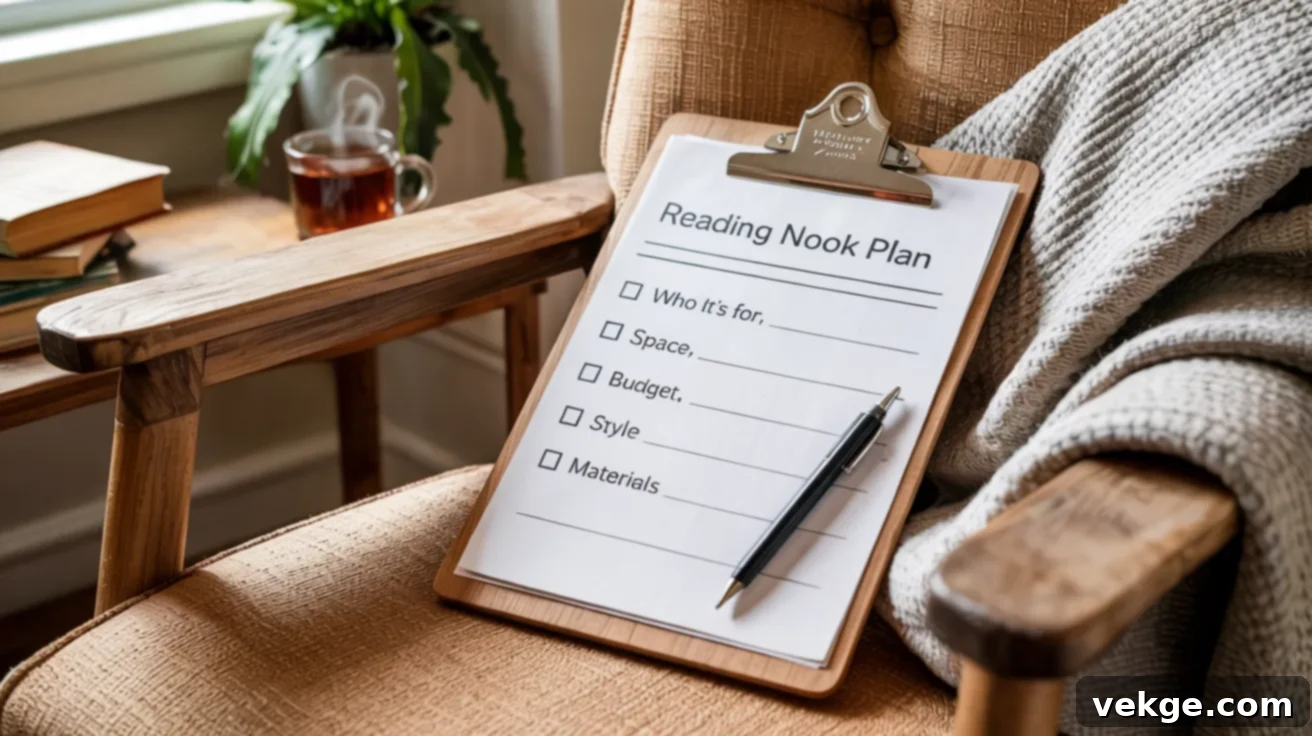
The very first step is to clearly identify the primary user(s) of the nook: Is it exclusively for yourself, a designated spot for a child, or a shared space intended for the whole family? This initial distinction will significantly influence many of your subsequent decisions regarding size, style, and safety. Next, carefully consider the actual amount of space you have available, taking precise measurements, and realistically assess how often the reading nook will be utilized. Will it be an everyday retreat, a weekend escape, or an occasional quiet corner?
Establishing a realistic spending limit early on is vital for staying on track. Decide whether you intend to build elements from scratch using raw materials, repurpose existing furniture and household items, or purchase a few select new items to complete your vision. Answering these foundational questions upfront will serve as a clear roadmap, guiding your choices, preventing wasted time or effort, and helping you avoid unnecessary expenses. A little strategic planning at this initial stage makes the entire creation process smoother, more enjoyable, and ultimately ensures that your new reading nook perfectly integrates into your lifestyle and meets all your expectations.
How to Measure and Outline Your Nook Setup
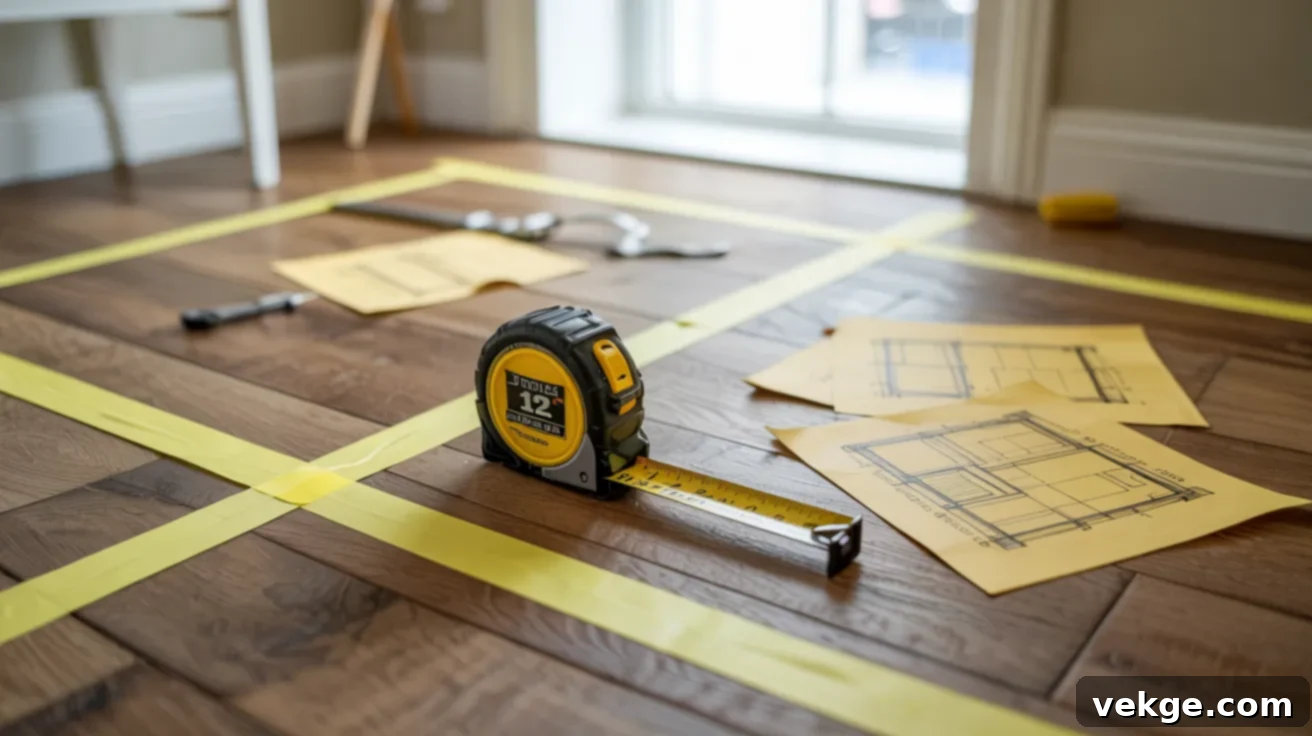
Visualizing your space before committing to any permanent changes is incredibly helpful. Use painter’s tape directly on the floor or even chalk to clearly mark the precise dimensions where your reading nook will be situated. This simple technique provides a tangible, clear sense of how furniture pieces, accessories, and even people will fit within the designated area, allowing you to adjust before investing. Precisely measure the width, depth, and height of your chosen space to understand its boundaries. For a more detailed plan, utilize simple online room planners or printable grid templates to sketch out various layout possibilities, experimenting with different arrangements until you find the perfect fit.
While there’s no strict universal rule, ideal reading nooks are typically at least 24 to 36 inches deep, offering enough room for comfortable seating, and wide enough to accommodate the user without feeling cramped or claustrophobic. Don’t forget to measure the available wall space if you’re planning to incorporate shelves, artwork, or wall-mounted lighting, ensuring everything has its place.
Picking a Style and Seating That Suits Your Space

Your measurements and the overall layout of your room will naturally guide you toward the most suitable seating choice for your reading nook. For narrow or confined spaces, a well-designed bench is often an excellent and space-saving option, as it can cleverly incorporate hidden storage underneath, maximizing functionality. Comfortable armchairs provide excellent back support and fit beautifully into corners, creating a defined personal zone perfect for sinking into. For very small spaces or children’s rooms, plush floor cushions, large bean bags, or even a soft pouf are incredibly versatile, inviting, and easy to move around.
The key is to match the type of seat to the user’s specific comfort needs and preferences, and critically, to ensure it physically fits the designated space without causing overcrowding or hindering movement. Remember, a practical, well-sized seating option that feels harmonious with its surroundings and doesn’t overwhelm the area is always superior to an oversized, impractical piece that looks out of place or makes the space feel smaller.
Building the Foundation for Comfort and Functionality
The foundation of your reading nook involves creating a sturdy and comfortable setup. This can be achieved either by embracing basic DIY tools and materials for a custom build or by opting for easy alternatives that require no drilling, cutting, or permanent modifications, making this project accessible for everyone regardless of their skill level.
DIY Bench with Integrated Storage
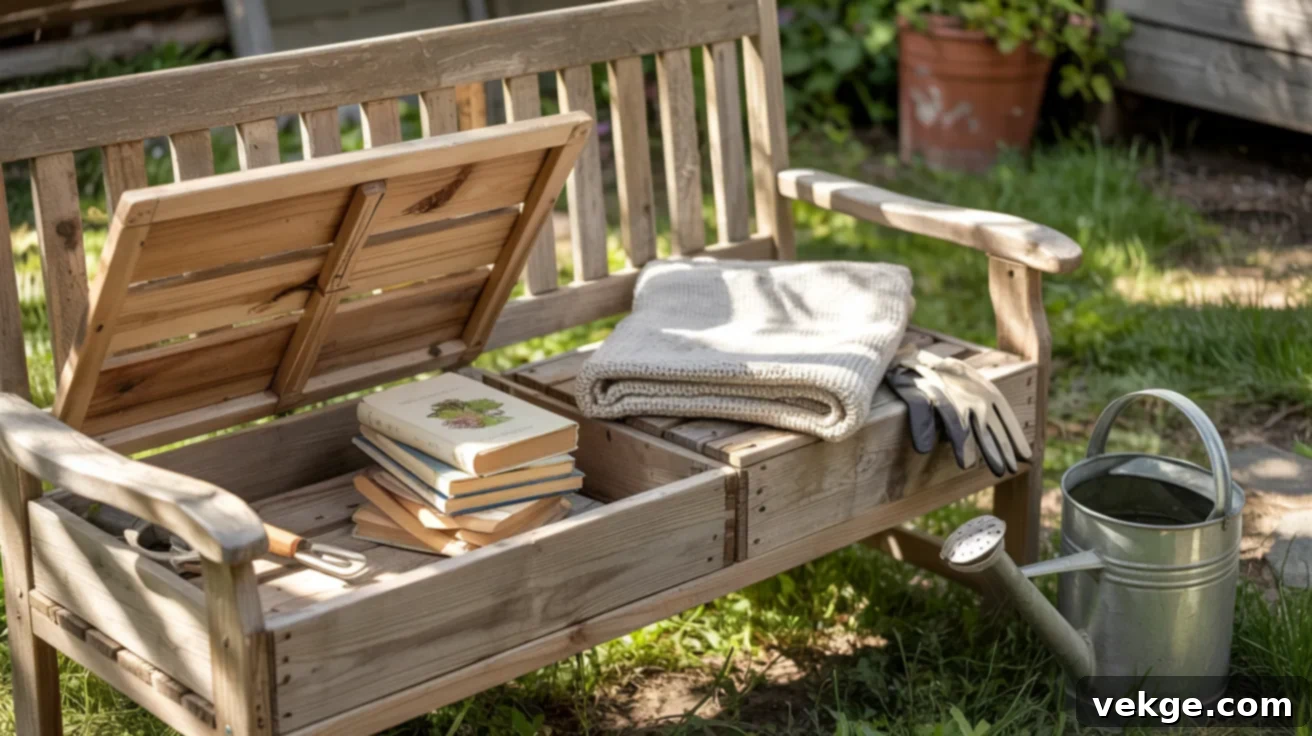
A custom-built bench is a highly versatile and efficient piece, serving both as comfortable seating and a clever storage solution for books, blankets, or other small essentials. For this project, you’ll need basic tools such as a drill, screws, and pre-cut wood panels (or the ability to cut them yourself to size). Begin by carefully measuring your designated area to determine the bench’s ideal dimensions, considering both seating comfort and storage capacity. Cut your wood panels to create the frame and support beams, ensuring robustness and stability. Assemble the frame securely with screws, then attach a flat top surface, which can be hinged for easy access to the storage compartment or simply secured in place with a comfortable cushion on top. To maximize storage, integrate bins, crates, or design hinged lids to conceal items neatly inside. Before finishing, sand any rough edges to ensure safety and a smooth feel. Finally, paint, stain, or seal the bench to match your room’s existing aesthetic, creating a polished and highly functional centerpiece for your nook.
Easy Setup Ideas Without Tools or Permanent Modifications
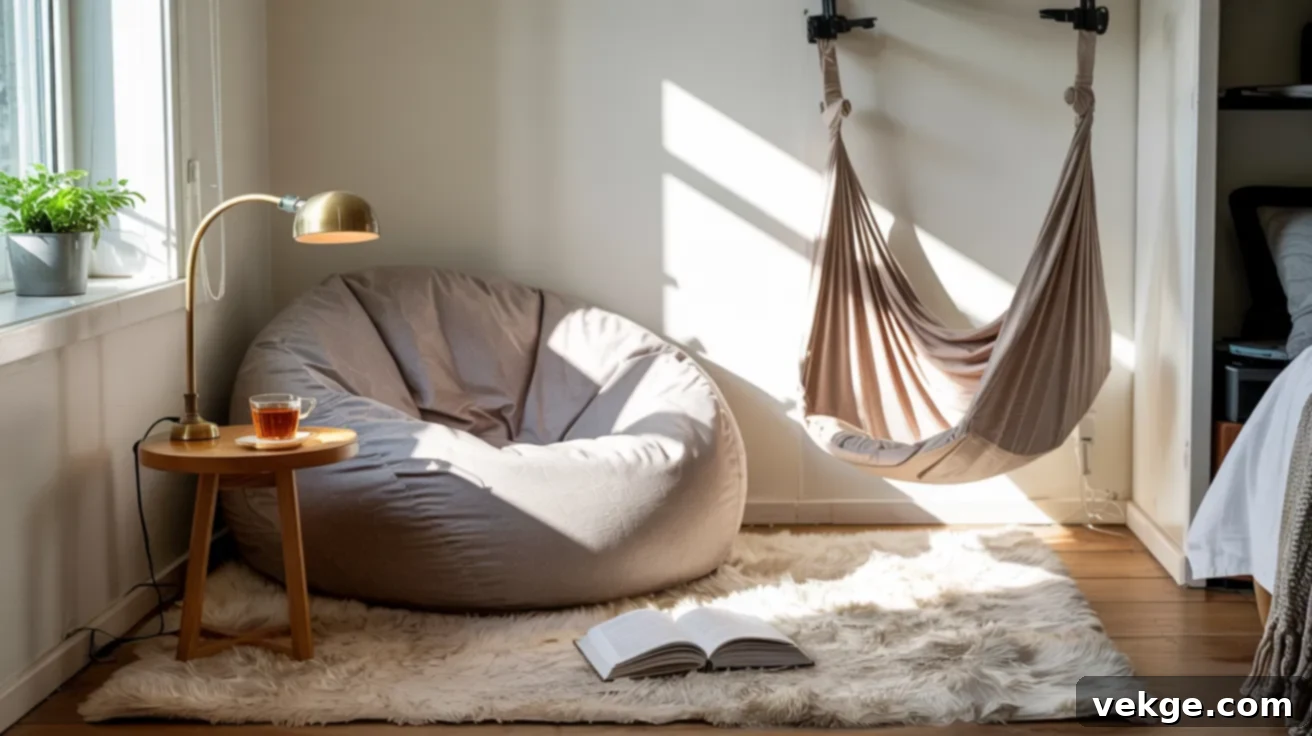
If you’re seeking a fast, hassle-free, and completely tool-free setup, many ready-made seating options are perfect for creating an instant cozy spot. Large bean bags, an array of plush floor cushions, or even comfortable folding chairs can instantly transform an empty corner into an inviting retreat. For a unique and perhaps playful touch, consider a small hammock or sling seat, provided it can be safely and securely installed with removable, renter-friendly hooks that don’t damage walls. Another wonderfully compact and cozy solution involves layering a soft, textured rug with several different cushions and pillows to create an inviting ground-level lounge area. Retailers like IKEA, along with various secondhand shops, online marketplaces, and even your own home, are excellent resources for discovering lightweight, space-saving, and budget-friendly items that require no special equipment or complex assembly. These options are ideal for renters, those on a tight budget, or anyone who prefers maximum flexibility and minimal fuss.
Adding Bookshelves or Smart Storage Solutions
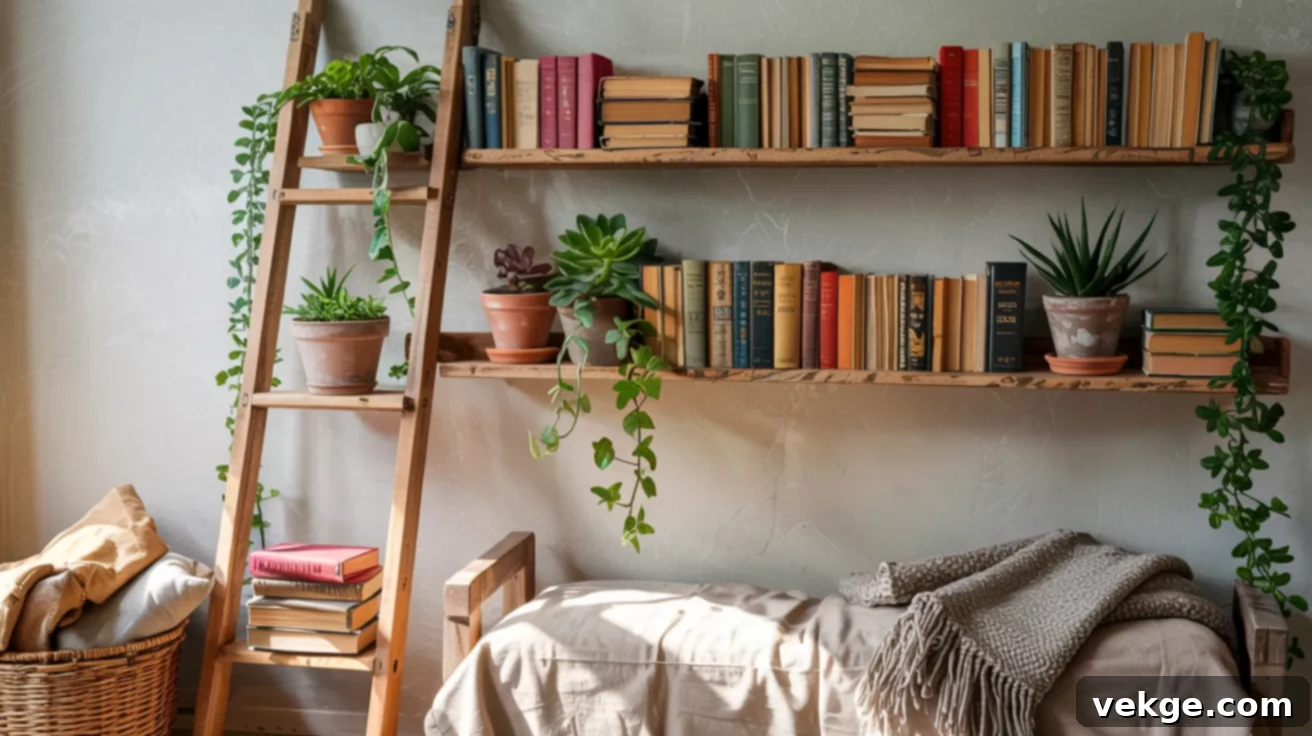
Keeping your reading materials and other essential items close at hand is crucial for a truly functional and relaxing reading nook. Utilize vertical space effectively with wall-mounted shelves, which are particularly well-suited for small areas and can be installed at varying heights to accommodate different book sizes or decorative items. Opt for lightweight, easy-to-mount options to simplify installation and avoid heavy-duty drilling. If your nook includes a bench, maximize the space underneath by incorporating baskets, decorative bins, or even custom-built drawers if you’ve chosen a DIY bench. For ultimate flexibility, rolling carts or leaning shelves can be fantastic additions, as they can be easily moved and repositioned as needed to suit your evolving preferences. Regardless of your choice, always ensure that any storage solution is stable, secure, and positioned within easy, comfortable reach of your central reading spot to enhance your reading experience and keep your sanctuary tidy.
Styling and Comfort Elements: The Finishing Touches
Once the foundation of your reading nook is in place, it’s time to infuse it with warmth, practicality, and an irresistibly inviting atmosphere. Focus on thoughtful lighting, luxurious and tactile fabrics, and those small, personal details that truly make the space feel like an extension of you and a delightful escape.
Illuminating Your Space: Lighting That Works
Proper lighting is paramount for a comfortable and strain-free reading experience. Begin by incorporating a dedicated task lamp that provides direct, focused light onto your book or magazine. Supplement this with soft ambient lighting, perhaps a small table lamp or indirect light from a floor lamp, to create a balanced and cozy glow that banishes harsh shadows. For renters or those seeking low-commitment options, clip-on or plug-in lamps are incredibly versatile, easy to install, and require no permanent fixtures. String lights can also add a wonderfully calm and magical mood without occupying any precious floor or table space, creating a whimsical touch. Always ensure your chosen light source is adjustable or strategically placed to minimize shadows on your reading material. Battery-operated lamps or puck lights are excellent solutions for areas where electrical outlets are scarce, offering flexibility and convenience.
Layering in Texture for Ultimate Coziness
Adding various layers of texture is the secret to making your reading nook feel soft, deeply welcoming, and utterly luxurious. Drape a plush throw or a small, soft blanket over your seating for instant warmth, an inviting look, and a tactile experience. Incorporate a comfortable seat cushion or a supportive pad to enhance ergonomic comfort and add another layer of softness. Finally, define the boundaries of your nook and add a layer of warmth and visual appeal with a soft rug underneath your seating area. These items don’t necessarily need to match perfectly; instead, focus on how their different textures complement each other and contribute to overall comfort and function. For small homes or shared spaces, opt for washable or easily foldable pieces for practicality and ease of maintenance. Changing out these textures seasonally can also keep your nook feeling fresh, engaging, and exciting throughout the year.
Personal Touches That Make It Yours
This is where your reading nook truly comes alive as a unique reflection of your personality and style. Add small, meaningful items that resonate with your aesthetic and genuinely enhance your reading experience without inadvertently creating clutter. This could be a small, easy-care plant that adds a touch of calming nature, a framed inspiring quote, a unique analog clock, or a stylish side table perfectly sized for placing a warm drink, a comforting snack, or your current book. The goal is to select a few practical extras that genuinely improve your time in the nook. Choose items that are easy to clean, maintain, or move if needed, ensuring the space remains low-fuss. Every chosen detail should contribute to making the space feel uniquely comfortable, inspiring, and effortlessly enjoyable each and every time you settle in.
DIY Reading Nooks by Style: Find Your Aesthetic
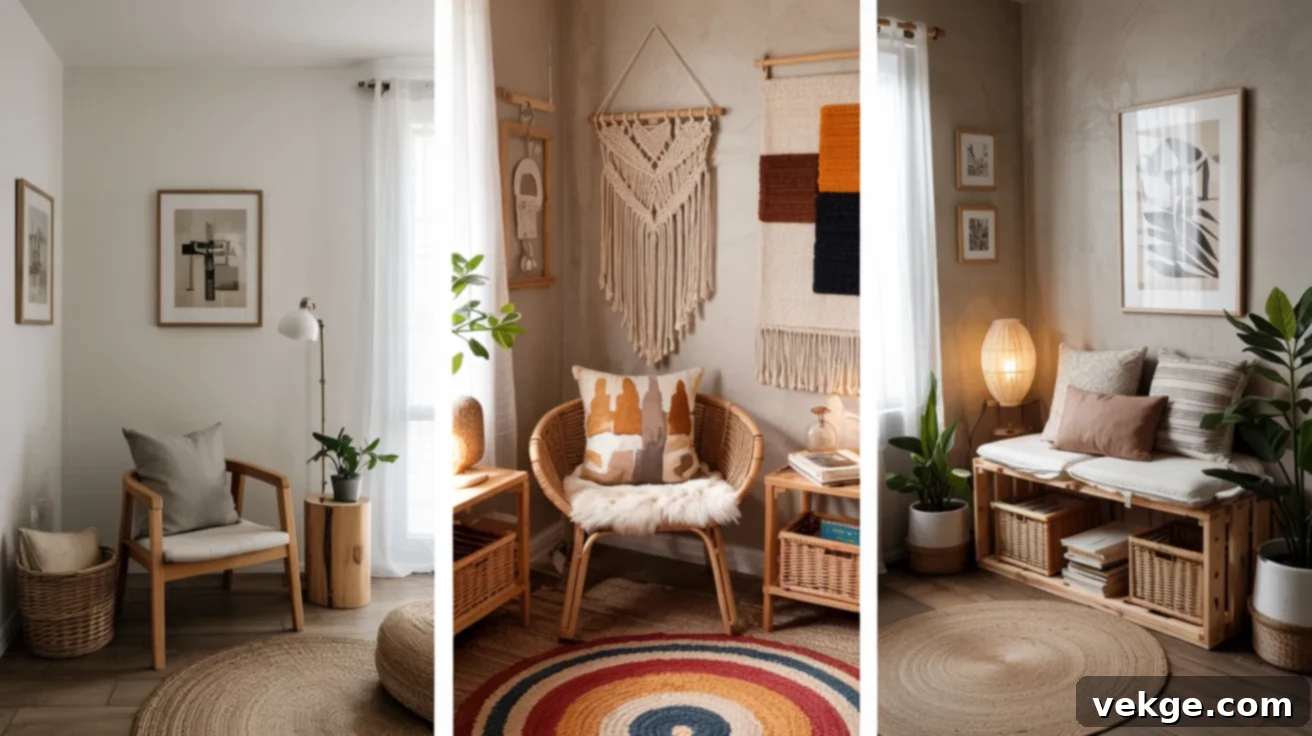
Your reading nook is a canvas for your personal taste and style. With thoughtful design choices and simple elements, you can shape the mood and aesthetic of your space, whether you prefer a clean and minimalist look, a vibrant and bohemian feel, or a warm and rustic ambiance. Explore these popular styles to inspire your own custom reading area, making it a true reflection of who you are:
|
Style |
Common Materials |
Color Scheme |
Layout Tips |
|
Minimalist |
Light-toned wood, sleek metals, natural cotton, crisp linen |
Crisp white, soft grays, warm beige, muted pastels, black accents |
Keep surfaces completely clear and uncluttered. Opt for a single, understated seating option and a sleek, simple task lamp. Focus on clean lines, functionality, and essential items only. |
|
Boho (Bohemian) |
Rattan, macramé, varied textiles (velvet, faux fur, woven), natural fibers, houseplants |
Warm earth tones, terracotta, deep greens, mixed patterns, vibrant jewel tones |
Embrace layering with an abundance of plush cushions and soft rugs. Incorporate hanging elements like macramé plant holders or soft string lighting for an ethereal glow. Mix textures and patterns freely for an eclectic feel. |
|
Rustic |
Raw or reclaimed wood, burlap, woven baskets, cast iron accents, stone elements |
Rich earth tones, deep browns, forest greens, muted reds, warm creams, charcoal grays |
Integrate a sturdy wooden bench or natural log seating. Use soft, warm lighting (e.g., Edison bulbs). Display books on open, natural wood shelving and accent with cozy, chunky knit blankets and elements inspired by nature. |
Budget Guide and Cost Breakdown for Your DIY Nook
Before embarking on your DIY reading nook project, it’s incredibly wise to carefully consider your financial parameters. Determine how much you are realistically willing to spend and identify which aspects of the nook are most important to you (e.g., superior seating comfort, extensive storage, or specific aesthetic elements). A fantastic way to save money and imbue your nook with unique character is to first look around your home for existing pieces you can repurpose or upcycle. That old trunk could become a charming bench, or a forgotten blanket could be transformed into your new cozy throw.
Beyond your own home, explore thrift shops, garage sales, online marketplaces, or even organize swaps with friends and family. These resourceful options can significantly help stretch your budget further. If you decide to purchase new items, prioritize the core elements first: comfortable, supportive seating and effective, eye-friendly lighting. You can always add storage solutions, decorative items, and personal touches gradually as your setup evolves and as your budget allows, spreading out the cost over time. Regardless of your financial constraints, a little upfront planning goes a long way in staying organized, making smart purchasing decisions, and avoiding unnecessary overspending on items you might not immediately need, ensuring your project remains enjoyable and stress-free.
Expert Tips from Designers and DIY Enthusiasts
Learn from the collective wisdom of experienced builders, interior designers, and passionate DIYers who have successfully crafted functional and beautiful reading spaces in homes of all shapes, sizes, and styles. Their invaluable insights can help you avoid common pitfalls, optimize your space, and ensure your DIY reading nook becomes everything you envision:
- Smart Furniture Selection: Always choose furniture pieces that fit comfortably within your designated space without blocking natural pathways or hindering movement. Measure twice, buy once, and consider multi-functional items.
- Maximize Natural Light: Whenever possible, position your reading nook to take full advantage of natural light. This not only reduces the need for artificial lighting during the day but also significantly minimizes eye strain, creating a more pleasant and invigorating environment.
- Clever Storage Solutions: Opt for storage that not only fits the physical space efficiently but also effectively minimizes visual clutter. Integrated storage within benches, wall-mounted shelves, and decorative, lidded baskets are excellent for maintaining a tidy and peaceful atmosphere.
- Cohesive Color Palette: Stick to a simple, harmonious color plan. A limited, calming palette helps create a sense of serenity and avoids visual noise, which can be distracting in a relaxation space. Use varying shades of the same color for depth.
- Purposeful Decor: Select items that truly serve a purpose or genuinely bring you joy. Avoid the temptation to fill the space with unnecessary extras. In a tranquil retreat, less is often more, promoting a sense of calm.
- Test Before Committing: Don’t rush into permanent decisions. Before building or buying, use painter’s tape on the floor, cardboard cutouts, or existing furniture to test different layouts and seating arrangements. Live with your temporary setup for a day or two to ensure it feels right and comfortable.
- Seek Feedback: If possible, ask for input from family members or close friends, especially if the nook is intended to be a shared space. A fresh pair of eyes can offer valuable perspectives and identify potential improvements before you finalize your setup.
One-Minute Quick Start Guide to Your Reading Nook
Short on time but eager to create your cozy corner right away? Use this streamlined, fast-track approach to get your essential reading nook ready without overthinking the details. You can always refine and enhance it later when you have more time and inspiration!
- Step 1: Choose Your Spot: Quickly identify a tucked-away corner or a quiet, low-traffic area where you can relax without immediate distractions.
- Step 2: Add Seating: Grab a comfortable chair you already own, a soft bench, a large cushion, or even a stack of plush floor cushions – whatever fits best and is immediately available to provide a soft base.
- Step 3: Set Up Lighting: Place a light source nearby. A clip-on lamp, a small table lamp, or even a standing lamp you can easily move will work perfectly to illuminate your reading material.
- Step 4: Include Soft Layers: Enhance comfort instantly by adding a favorite throw blanket, a cozy cushion, or a soft pillow to your chosen seat for added warmth and plushness.
- Step 5: Finish with Simple Details: Arrange your current books within easy reach on a nearby surface or stack. Add just one small item you enjoy looking at, like a small plant, a meaningful photograph, or a scented candle, to make it feel personal and inviting.
Conclusion: Your Journey to a Perfect Reading Haven Begins Now
You’ve now explored a comprehensive guide detailing how to plan, design, and set up your very own DIY reading nook. I sincerely hope this detailed walkthrough has not only inspired you but also equipped you with the confidence and practical steps needed to embark on this rewarding home improvement project yourself. Remember, the journey begins with simply picking a suitable spot, adding comfortable and supportive seating, ensuring adequate and inviting lighting, and then infusing it with those thoughtful, personal touches that truly make it your own tranquil haven.
There’s absolutely no need to complete everything in a single session. Feel empowered to start small, perhaps with just a comfortable chair and a good light, and gradually build upon it over time, adding elements as your budget and inspiration allow. Whether this personalized space is intended exclusively for you, a beloved family member, or as a shared retreat for everyone, even the simplest setup has the profound potential to transform into a beloved corner of your home—a cherished place where comfort, quiet contemplation, and the timeless joy of reading beautifully converge. If you found this guide helpful and inspiring, I encourage you to explore some of my other posts; you might just discover your next favorite home improvement or DIY project there, too!
